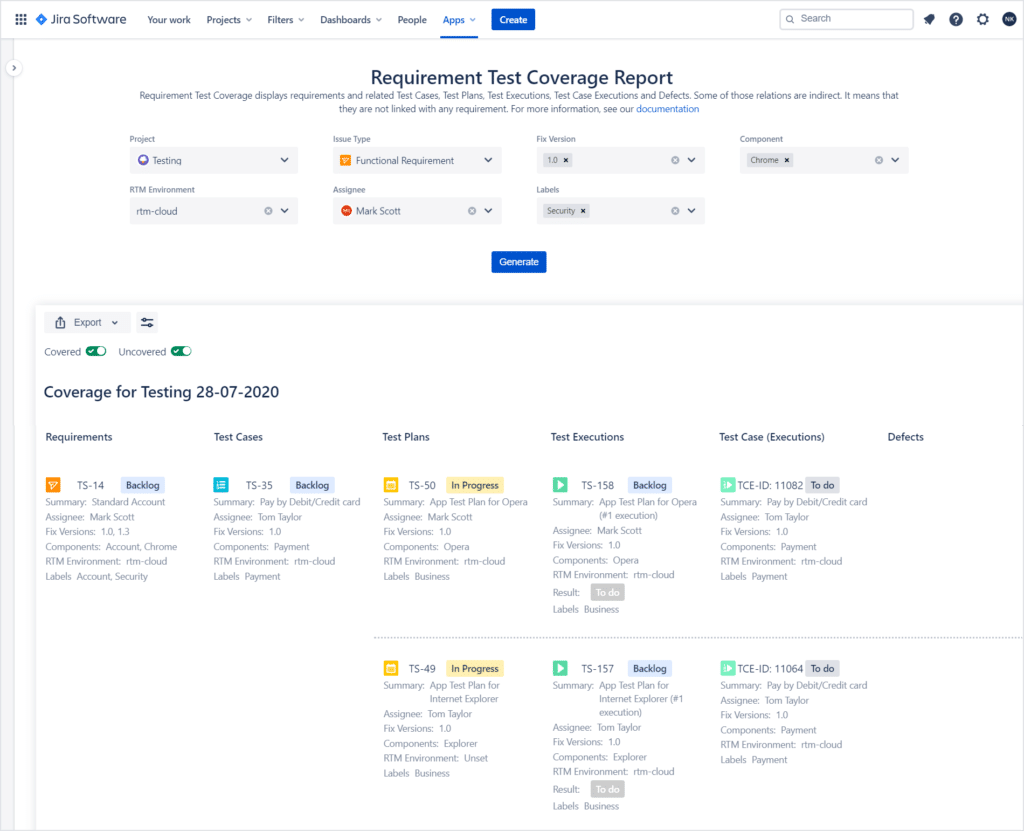How to create and use the Requirement Traceability Matrix in Jira?

Originally published June 14, 2019, updated for accuracy April 29, 2024
Using the requirements traceability matrix in Jira for testing can be great for your team. The feature simplifies test tracking and workflow organization. It results in improved QA processes and a notable reduction in potential bugs. Discover how to set up the traceability matrix that matches your needs.
Table of contents
- Types of traceability in Atlassian’s Jira
- What is the requirements traceability in Jira?
- Can Jira track requirements? Does Jira have a traceability matrix?
- Requirements and Test Management for Jira
- 5 reasons why having a requirements traceability matrix in Jira is important for your testing project
- How do you create a requirement traceability matrix in Jira?
- How to use the requirements traceability matrix in RTM for Jira effectively?
Types of traceability in Atlassian’s Jira
Traceability helps teams keep track of their project tasks and understand how they fit into the bigger picture. There are two main types of traceability: forward and backward.
- Forward Traceability – is like following a trail from the start to the end of a project. It involves linking bigger tasks, such as main features, to smaller steps needed to complete them. This helps teams see the progress and how everything fits together.
- Backward Traceability – involves looking back to understand why a certain task was done. It means tracing back from smaller tasks to see what bigger goal they’re connected to. This helps teams remember the purpose behind each task and stay focused.
Both types ensure that teams stay aligned with project objectives.
What is test coverage in Jira?
When it comes to testing, checking coverage is crucial to releasing a bug-free product. In Jira, test coverage tells you how much of your software is tested. It shows if all the important parts are checked by your tests. High test coverage means more of your program is examined. Low test coverage means some parts might not be thoroughly tested and require attention.
What is the requirements traceability in Jira?
Requirements traceability means connecting testing tasks to specific project requirements. This ensures that each activity aligns with the project’s goals. Traceability tools help your team double-check if the important aspects weren’t overlooked.
When used right, a Traceability Matrix can be your GPS for your QA journey.
QA software testing
The quote above is very much to the point. Traceability gives you multiple tracking possibilities. You can analyze the testing object relations and follow every phase step by step like GPS instructions. Thanks to this, your team can reach the project’s goal at the minimum cost and time and maximum quality.
Can Jira track requirements? Does Jira have a traceability matrix?
Native Jira doesn’t have a traceability matrix for testing among its functionalities. The basic features of the Atlassian product often aren’t enough for advanced users. Especially when you aim for a consistent testing process. The majority of projects tend to require more complex solutions. Fortunately, there’s a wide range of dedicated test management plugins designed to make testers’ work more efficient. One of them is our Requirements and Test Management for Jira (RTM).
Requirements and Test Management for Jira
Requirements and Test Management for Jira allows one to track the whole project from end to end. Gather requirements, assign test cases to them, set up test plans, and verify their executions. Report defects, and check coverage. You can do all that in a single place. Last but not least, the app lets you seamlessly link testing objects to Jira epics and user stories. You can also search for them like for regular Jira issues. Using RTM for Jira, you’ll get an embedded process inside the project management tool you and your team already know.
5 reasons why having a requirements traceability matrix in Jira is important for your testing project
1. Improved relations visibility
- Ensure your requirements align with test cases.
- Identify relations and coverage gaps to take prompt action.
2. Supported change management
- Easily assess the impact of changes on related tasks.
- Take swift action as project requirements evolve.
3. Smooth collaboration process
- Simplify the review of requirements for the stakeholders.
- Detect and resolve inconsistencies early in the process.
4. Reduced risk in final releases
- Minimize defects in the final product.
- Improve customer satisfaction and confidence.
5. Consistent testing cycle
- Highlight areas not covered by tests.
- Prioritize testing efforts and maintain project scope.
How do you create a requirement traceability matrix in Jira?
Can we create RTM in Jira?
As mentioned before, Jira doesn’t provide a built-in requirements traceability matrix. This is why we will explain the configuration using an example of Requirements and Test Management for Jira plugin.
How to create the traceability matrix in Requirements and Test Management for Jira?
The Traceability Matrix is a special panel that lists issues of one type and verifies their associations with requirements, tests, or defects. It also shows the total number of relationships for each issue and the percentage of coverage for both the X and Y axes (columns and rows of the chart).
To set up the matrix in RTM for Jira:
- Navigate to the Reports section and click on the Traceability link.
- In this report, select the Issue type you want to display in rows and then the one you want to display in columns. Use the provided list.
- After making your selections, click the Generate button. This will display a transparent matrix allowing you to assess the coverage of your chosen issue types, such as requirements and test cases.
- Modify or refine the results using the filters located at the top of the table. You can also input commands in the JQL language.
- To save the data, locate the Export button at the top right of the report and choose either PDF or CSV format.
How to use the requirements traceability matrix in RTM for Jira effectively?
The Traceability Matrix is perfect for tracking requirements and test case coverage. The feature allows you to choose among functional, non-functional, UI, and business requirements. It displays only the relations you’d like to see at the moment. With the matrix, linking requirements to test cases becomes clear for everyone.
The Requirements Traceability Matrix presents a relationship comparison between two baselined issue types of our choice on a dedicated view. It can show you more than just associations between requirements and test cases. It also lets you:
- make sure all test cases are included in test plans and test executions;
- find defects resulting from particular test cases and test executions;
- verify test executions linked to test plans.
Thanks to the report, you can see at a glance which tasks take more time than others or cause difficulties. Secondly, you can check if the test executions are complete as planned. Finally, you can look for defects and if there are any, track their source. Knowing from which testing object they result, simplifies fixing them without messing with other parts of the project.
FAQ
-
How do I create a matrix in Jira?
Before you start:
- Make sure you have an active Jira Product Discovery license.
- Prepare values for the x and y axes field to show up in the plot.
Steps:
- In Jira Product Discovery (JPD), choose a project.
- Go to Views > + Create a view > Create a new matrix.
- Before you see the matrix, pick values for the X-axis and Y-axis. Choose a field for each axis. As you change the axis fields, the positions of the idea bubbles change accordingly.
-
How do I create a traceability report in Jira?
For your testing needs, explore testing apps on the Atlassian Marketplace. These plugins offer matrix features tailored to your QA team. They present detailed data to support your testing efforts. If you decide on Requirements and Test Management for Jira, take a look above. We explained in detail how to set up and benefit from the Traceability Matrix feature the most.






